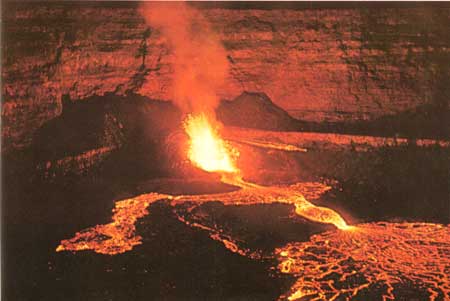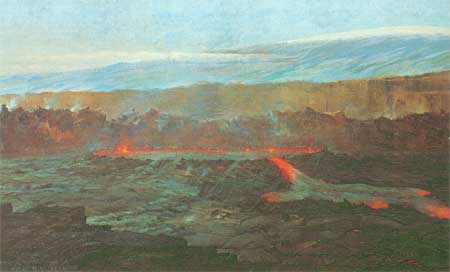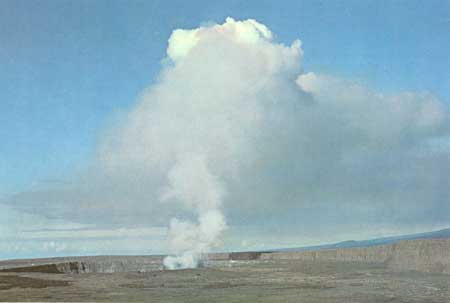|
HAWAI'I VOLCANOES & HALEAKALA Volcanoes of the National Parks of Hawaii |

|
KILAUEA, HOME OF PELE, THE FIRE GODDESS
Description. Kilauea also is a shield volcano, closely resembling Mauna Loa in its structure, built against the side of its larger neighbor. Small compared to Mauna Loa, Kilauea is no pygmy. Its summit stands some 20,000 feet above the surrounding ocean floor. Kilauea has been built largely by eruptions from two rift zones, extending eastward and southwestward from the summit caldera. The rifts are marked at the surface by many cinder and spatter cones, pit craters, and open fissures. The Chain of Craters road passes close to several of the pit craters on the east rift zone, and cuts through the edge of a small cinder cone revealing its internal structure. Noteworthy among the fissures on the southwest rift are the Great Crack, continuous for more than 10 miles, from which issued the 1823 lava flow of Kilauea; and the large fissures crossed by the road at the southwestern edge of the caldera.
The summit caldera ("crater") of Kilauea is 2-1/2 miles long and 2 miles wide (Plate 1) and its floor has an area of approximately 2,600 acres. At its northeastern edge, below the Volcano House, and at its western edge, below the Uwekahuna overlook, the wall of the caldera consists of a series of step-like fault blocks (Plate 1). Just north of Uwekahuna the boundary cliff is about 400 feet high. The entire floor of the caldera, except for a narrow peninsula projecting from the southeastern side, is made up of new lava flows erupted within the last century. (See Figure 4.) Near its southwestern edge the caldera floor is indented by the depression Halemaumau, the "Fire Pit," a collapsed crater about 3200 feet wide. Halemaumau is the focus of Kilauea's eruptive activity and the traditional home of Pele, the Hawaiian goddess of volcanoes.

PLATE 6. Night view of the July 1961 eruption within
Halemaumau. NPS photo by L. R. McBride

PLATE 7. Halemaumau, as painted by D. Howard Hitchcock in
1894. NPS photo by W. M. Rabenstein.
The pit craters along the rift zones are formed by collapse caused by removal of support. Some of the smaller ones may be formed by draining of large lava tubes underneath, with resulting collapse of the overlying rock material into the tube. The larger ones, such as Makaopuhi Crater (Figure 8), probably form above pluglike bodies of magma that work their way upward along the rift zone. Partial withdrawal of the magma causes the unsupported mass of rock above to sink in.
Many fault scarps can be seen on Kilauea, The walls of the great caldera are themselves fault scarps left by the down-sinking of the floor. Along the rift zones elongate blocks of rock known as grabens have sunk down between two parallel faults, leaving infacing fault scarps at their edges. Along the southern coast Hilina Pali and its associated cliffs are scarps marking faults along which portions of the mountain have slid downward and outward toward the ocean.
Kilauea differs from Mauna Loa in two principal respects, both minor matters volcanologically. One is the greater amount of explosive debris in the vicinity of the caldera. The other is the lava lake activity that existed for many years in the caldera (Figure 5). The explosive debris around Kilauea caldera is of two types. One consists largely or entirely of fragments of glass — the quickly frozen spray of lava fountains. Deposits of this type of material are buff to yellow in color, and generally sandy in texture. They are well exposed in road cuts, fault scarps, and walls of cracks around the eastern, southern, and southwestern edges of the caldera. In the same area a layer of pumice fragments lies on the ground surface. The pumice is the frozen froth of lava fountains that played in the caldera and in Kilauea Iki Crater.

PLATE 8. Rising steam column capped by a cumulus cloud over
Halemaumau, 1961. NPS photo by William Dunmire.
The second type of explosive debris consists largely or entirely of stony fragments of older lavas, ranging in size from dust to blocks several feet across, broken up and thrown out by violent steam explosions. Two such periods of steam explosions have occurred during recent times, one about 1790 and the other in 1924 (described later). Debris thrown out in 1790 covers the ground surface in the vicinity of the Uwekahuna overlook. Material from the explosions in 1924 forms the surface around Halemaumau, and is abundant near the parking area. One block weighing about 8 tons was thrown 1,000 feet east of the present parking area and 3,000 feet from the center of Halemaumau. A still larger block, weighing about 14 tons, formerly lay near the rim of Halemaumau, but fell back into the pit during a collapse of part of the rim.
A special type of explosive debris is the black sand that composes the beaches near Kalapana and Punaluu, Where aa lava flows into the sea the contact of the hot lava with sea water causes steam explosions that throw up droplets and fragments of the hot lava. The droplets of still molten lava are quickly chilled to a black or dark brown glass. The debris from the explosions accumulates to form one or more small hills at the edge of the water. These hills are attacked by the ocean waves and soon eroded away. Of three such hills formed by the 1840 lava flow of Kilauea, one is already completely removed. The sand-size fragments, moved along the shore by the waves and currents, accumulate at favorable places to form beaches of black glass sand.
Table 3 lists the historic lava flows of Kilauea, The table ignores the long periods of constant lava lake activity at Kilauea, except when overflows of the lake produced noteworthy lava flows on the caldera floor. Undoubtedly many more of the latter occurred than are shown, especially during the early part of the historical period when records of the activity were poor.
TABLE 3—Eruptions of Kilauea1
| Year | Date of outbreak |
Duration (days) | Altitude (feet) |
Location | Approximate repose period since last eruption (months)2 |
Area (sq. miles) | 27Volume (cu. yards) |
| 1750 (?) | ---- | ---- | 1,700 | E. rift | ---- | 1.57 | 19,500,000 |
| 1790 (?) | ---- | ---- | 1,100-750 | E. rift | ---- | 3.04 | 37,670,000 |
| 3l790 | November (?) | ---- | ---- | Caldera | ---- | No lava flow | No lava flow |
| 1823 | Feb.-July | Short | 1,700-250 | SW. rift | ---- | 43.86 | 415,000,000 |
| 1832 | Jan. 14 | Short | 3,650 | E. rim of caldera | ---- | (?) | (?) |
| 1840 | May 30 | 26 | 3,100-750 | E. rift | ---- | 46.60 | 4281,000,000 |
| 1868 | April 2 | Short | 3,350 | Kilauea Iki | ---- | .07 | (?) |
| 1868 | April 2 (?) | Short | 2,550 | SW. rift | ---- | .04 | 250,000 |
| 1877 | May 4 | 1 (?) | 3.500 (?) | Caldera wall | ---- | (?) | (?) |
| 1877 | May 21 (?) | ---- | 3,450 (?) | Keanakakoi | ---- | .04 | (?) |
| 1884 | Jan. 225 | 1 | -60 (?) | E. rift | ---- | (?) | (?) |
| 1885 | March | 80 (?) | 3,640 (?) | Caldera | 14 | (?) | (?) |
| 1894 | Mar. 21 | 6+ | 3,690 | Caldera | 108 | (?) | (?) |
| 1894 | July 7 | 4 (?) | 3,690 | Caldera | 3.5 | (?) | (?) |
| 1918 | Feb. 23 | 14 | 3,700 | Caldera | 283 | .04 | 250,000 |
| 1919 | Feb. 7 | 6294 | 3,700 | Caldera | 11 | 1.60 | 34,500,000 (?) |
| 1919 | Dec. 21 | 221 | 3,000 | SW. rift | 1 | 5.00 | 62,000,000 |
| 1921 | Mar. 18 | 7 | 3,700 | Caldera | 7.5 | .77 | 8,800,000 |
| 1922 | May 28 | 2 | 2,650-2,400 | Makaopuhi and Napau | 14 | .04 | (?) |
| 1923 | Aug. 25 (?) | 1 | 3,000 | E. rift | 15 | .20 | 100,000 |
| 71924 | May 10 | 17 | ---- | Caldera | 8 | No lava | No lava |
| 1924 | July 19 | 11 | 2,365 | Halemaumau | 2.5 | .02 | 320,000 |
| 1927 | July 7 | 13 | 2,400 | Halemaumau | 35 | .04 | 73,160,000 |
| 1929 | Feb. 20 | 2 | 2,500 | Halemaumau | 19 | .06 | 1,920,000 |
| 1929 | July 25 | 4 | 2,560 | Halemaumau | 5 | .08 | 3,600,000 |
| 1930 | Nov. 19 | 19 | 2,600 | Halemaumau | 15.5 | .09 | 8,480,000 |
| 1931 | Dec. 23 | 14 | 2,700 | Halemaumau | 12.5 | .12 | 9,640,000 |
| 1934 | Sept. 6 | 33 | 2,800 | Halemaumau | 44 | .16 | 9,500,000 |
| 1952 | June 27 | 136 | 2,870 | Halemaumau | 212.5 | .23 | 64,000,000 |
| 1954 | May 31 | 3 | 3,180 | Halemaumau and caldera | 18.5 | .44 | 8,500,000 |
| 1955 | Feb. 28 | 88 | 150-1,310 | E. rift | 8.9 | 6.10 | 120,000,000 |
| 1959 | Nov. 14 | 36 | 3,500 | Kilauea Iki | 53.5 | .24 | 51,000,000 |
| 1960 | Jan. 13 | 36 | 100 | E. rift | 0.8 | 4.1 | 155,000,000 |
| 1961 | Feb. 24 | 1 | 3,150 | Halemaumau | 12.2 | .02 | 830,000 |
| 1961 | Mar. 3 | 22 | 3,150 | Halemaumau | 0.2 | .1 | 350,000 |
| 1961 | July 10 | 7 | 3,150 | Halemaumau | 3.5 | .4 | 17,300,000 |
| 1961 | Sept. 22 | 3 | 2,600-1,300 | 9E. rift | 2.2 | .3 | 3,000,000 |
| 1962 | Dec. 7 | 2 | 3,250-3,100 | 10E. rift | 14.4 | .02 | 430,000 |
| 1963 | Aug. 21 | 2 | 3,150-2,700 | 11E. rift | 8.4 | .06 | 1,100,000 |
| 1963 | Oct. 5 | 1 | 2,750-2,300 | 12E. rift | 1.4 | .6 | 10,000,000 |
| 1965 | Mar. 5 | 10 | 3,000-2,300 | 13E. rift | 17.0 | 3.0 | 23,000,000 |
| 1965 | Dec. 24 | < 1 | 3,150-3,000 | 14E. rift | 9.5 | .23 | 1,160,000 |
| 1967 | Nov. 5 | 251 | 3,150 | Halemaumau | 23.3 | .25 | 110,000,000 |
| 1968 | Aug. 22 | 5 | 2,900-1,900 | 15E. rift | 1.3 | .01 | 16500,000 |
| 1968 | Oct. 7 | 15 | 3,000-2,400 | 17E. rift | 1.3 | .8 | 9,000,000 |
| 1969 | Feb. 22 | 6 | 3,100-2,900 | 18E. rift | 4.0 | 2.3 | 22,000,000 |
| 1969 | May 24 | 19867 | 3,150 | 20E. rift | 2.0 | 19.3 | 242,000,000 |
| 1971 | Aug. 14 | < 1 | 3,660-3,600 | Caldera | 210 | .8 | 12,400,000 |
| 1971 | Sept. 24 | 5 | 3,740-2,730 | Caldera and SW. rift | 0 | 1.5 | 2210,500,000 |
| 1972 | Feb. 4 | 19455 | 3,150 | 20E. rift | 4 | 13.5 | 163,800,000 |
| 1973 | May 5 | < 1 | 3,340-3,250 | 23E. rift | 0 | .1 | 241,600,000 |
| 1973 | Nov. 10 | 30 | 3,250-2,900 | 25E. rift | 0 | .4 | 3,700,000 |
| 1973 | Dec. 12 | 19203 | 3,150 | 20E. rift | 1 | 3.1 | 39,300,000 |
| 1974 | July 19 | 3 | 3,600-3,520 | Caldera and E. rift | 0 | 1.2 | 9,000,000 |
| 1974 | Sept. 19 | < 1 | 3,680 | Caldera | 2 | .4 | 2614,000,000 |
| 1974 | Dec. 31 | < 1 | 3,600 | Caldera | 3 | 2.9 | 2219,600,000 |
1Many eruptions have occurred on the floor of the caldera, but only a few of the later ones are listed here, data being inadequate or totally lacking for the earlier ones. On January 11, 1928, a small amount of lava was extruded on the floor of Hulemaumau, but this is believed to have been squeezed out by the weight of a heavy landslide on the crust of the 1927 lava which was still fluid beneath (Jaggar, T. A., Volcano Letter 370, 1932). 2During the early historic period Kilauea Caldera was observed only occasionally, and no definite record exists of the many caldera flows which are known to have occurred. 3Violently explosive. 4Area above sea level. The volume below sea level is unknown; but estimates give the following orders of magnitude: 1823 — 3,000,000 cubic yards; 1840 — 200,000,000 cubic yards. These are included in the volumes given in the table. 5Pacific Commercial Advertiser, Feb. 2, 1804. "A column of water, like a dome, shot several hundred feet up into the air, accompanied with clouds of smoke and steam." No further eruption was observed next day. 6Several separate flows, with short intervals without extrusion. 7Violent phreatic explosions, possibly accompanied by a submarine lava flow on the E. rift. 8About 320,000 cubic yards of lava poured into Halemaumau, but most of it drained back into the vents. 914 outbreaks along a 13-mile stretch of Napau Crater. 105 outbreaks from Aloi Crater to Kane Nui o Hamo. 11In and near Alae Crater. 12In and near Napau Crater. 13Makaopuhi Crater to Kalalua Crater. 14In and east of Aloi Crater. 15In Heake Crater and at scattered points for 13 miles eastward. 16About 4,000,000 cubic yards poured into Heake Crater, but most of it drained back into the feeding fissure at the end of the eruption. 17From the east flank of Kane Nui o Hamo for about 2 miles eastward. 18Between Alae and Napau Craters. 19The very long duration of activity is more comparable with the long-continued activity in Halemaumau previous to 1924 than with the other eruptions listed in this table. 20Mauna Ulu, between Aloi and Alae Craters. 21Activity was continuous at Mauna Ulu, on the east rift. 22The volume is only approximate because of the difficulty in estimating the large amount that poured into open cracks. 23From 0.6 mile west of Hiiaka Crater to Pauahi Crater. 24Of this, about 300,000 cubic yards drained down into fissures in the floors of the craters. 25From Pauahi Coaler eastward 1.5 miles to near Puu Haluhulu. 26Of this, about 6,000,000 cubic yards drained down into cracks in the floor of Halemaumau. 27Since 1960 all areas and volumes are based on mapping and estimates by the staff of the Hawaiian Volcano Observatory. | |||||||

PLATE 9. Kilauea explosion cloud, resulting from the steam
eruption of May 1924. The steam explosions, caused by ground water
entering the hot vent, threw clouds of steam and ash to heights of more
than 20,000 feet. Photo by Tai Sing Loo